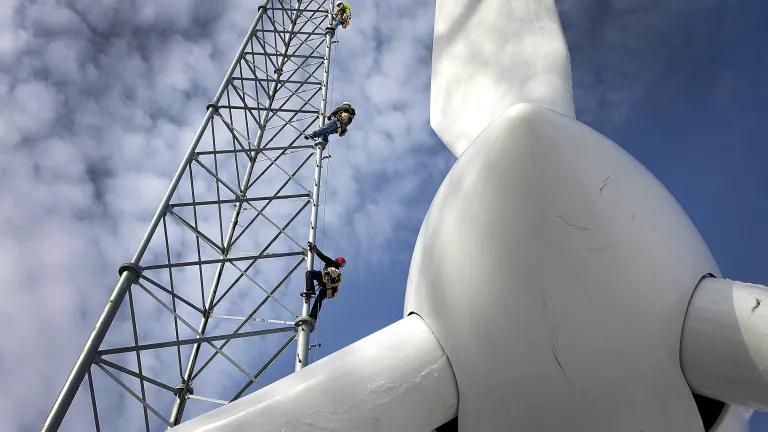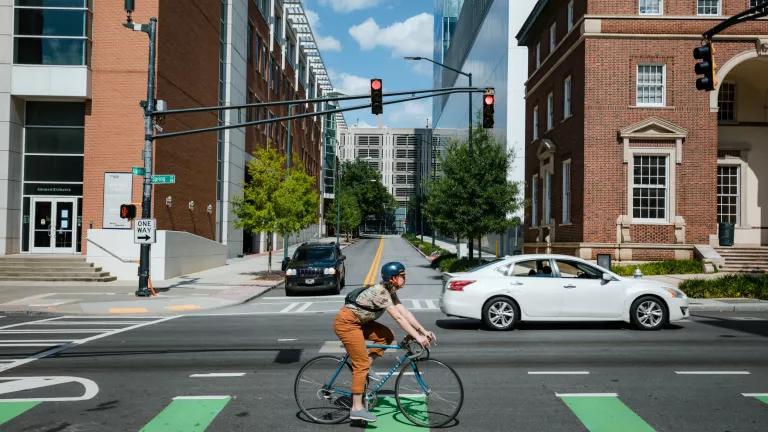
Among Washington DC lobbyists who oppose environmental legislation, one of the most common tactics for squelching an idea is to suggest it isn’t going anywhere. What this really means is, “I don’t want it to go anywhere, and that is more likely if I make you feel discouraged.”
George Will uses this device in his recent Washington Post op-ed disparaging the value of home energy upgrades and high-speed rail in addressing the climate crisis. “America is not going to retrofit every building,” Will writes, “Or wean people off air travel and get them onto high-speed electric trains like the forever-hypothetical one between Los Angeles and San Francisco that California is failing to build…”
But Will has chosen to naysay two solutions that can be evaluated with measurable results. These results undercut both his claims.
The first question—could we retrofit all homes in America before 2030—arose in the early 1980s after more than five years of home weatherization efforts produced significant utility bill savings for residents but failed to achieve the widespread energy savings that advocates believed were possible. My colleague at NRDC Ralph Cavanagh and I proposed a joint experiment with the utility then known as Pacific Power and Light to see how close we could come to producing deep retrofits of all homes. We selected a small community for a pilot program. The program was designed in about a year and implemented over the next three years, then evaluated with metered results.
The outcome was encouraging: We retrofitted 85 percent of all homes to a set of advanced energy efficiency specifications that NRDC and Pacific Power had agreed upon, reducing energy use to a level even lower than what we expected. The weatherization retrofit also cut peak heating power needs for heating, a major cost savings to the utility that we had not counted on.
A decade later, Pacific Gas and Electric repeated this experiment with an emphasis on reducing power demand for cooling, not heating. The results were similar, with again about 85 percent market share and impressive cooling power savings.
So the question of can we retrofit every home by 2030 has been answered. (Details in the linked article and its referenced paper.) If we can do this before 2025 in pilot communities, the only constraint to taking it national is getting insulation companies and window companies and air conditioner manufacturers to increase their production levels (by building new factories or lines and hiring more workers) and training the additional construction workers needed to install and test these products. These changes won’t happen overnight, but it is also clear that they won’t take as long as 10 years.
Considering the building sector accounts for nearly a third of U.S. greenhouse gas emissions, the payoff in terms of avoided pollution is worth pursuing.
The question is not about technology or economics, it is about the political will (pun intended) to do so. By casting uninformed aspersions in his column, Will is opposing the policy of promoting retrofits without offering any reasons why it might not be a good idea. Perhaps that’s because it’s hard to find such reasons: a national retrofit effort would produce over half a million jobs, improve health and comfort, increase property values, and save money for consumers. These pilot programs were not “big government,” as they were operated and paid for by investor-owned utilities.
Will then goes on to dismiss the prospect of a high-speed rail system in California. Perhaps if he and his ideological bedfellows had not spent the last 40 years calling railroads socialist for no apparent reason, the political prospects would be better. Unfortunately, rail construction has become a partisan issue in America. It is hard to understand how self-declared conservatives could think that railroads are socialist when rail’s competitors—highways and airplanes—require even greater government expenditures. After all, the cost of building airports and highways falls entirely to the government, while the cost of rail can be shared with private sector operators and is about half as much per passenger mile.
By investing some $80 billion in rail in California, the government avoids investing some $180 billion in airports and freeways and parking. Wouldn’t an opponent of big government prefer to avoid the default result of $180 billion of government expenditures in favor of a lower-cost plan that is only partly reliant on government funding?
The only real barrier to completion of high-speed rail is deciding to do so and providing the funds. That is why so many other countries have been able to build and operate such systems for 50 years.

High speed rail in Austria
If influential conservatives such as George Will were to support high speed rail, the project could move forward and pay back dividends in avoided pollution from the transportation sector, now the leading source of U.S. emissions.
Will says “government inefficiency and regulatory capture made airlines expensive and inconvenient until deregulation democratized air travel,” but he ignores the reality that partial deregulation also made air travel unreliable, inconvenient, and uncomfortable, without any possible relief. It’s not as if deregulation offered consumers more choice, such as paying more for reliable schedules.
Across over 6 million miles of lifetime travel, I have had plenty of time to observe how undependable air travel has become, especially if you are not flying to one of the biggest airports. But when I travel to Germany, China, France, and many other countries, I find trains that are on time to the minute, run every hour or so, even to minor cities, and are much more comfortable than flying. Is Will saying that America can’t build the same (much less better) systems that other countries have already built?

Waiting for a delayed flight in America
Another unnecessary diversion is Will’s assertion that Democrats have been “tepid” in supporting what he calls “the most efficient way to reduce carbon,” a carbon tax. This statement is both divisive and wrong.
It is divisive because many progressives and some conservatives have supported a carbon tax, as have many environmental advocacy organizations. NRDC has supported carbon pricing since at least 1990. An attempt to blame the lack of carbon pricing on either the left or the right is not consistent with the evidence, thus doing so is divisive.
It is wrong because we have seen that higher fossil fuel prices do not produce much, or even any, reduction in demand. To the extent they do anything, carbon fees induce modest changes in supply. While price-induced changes in electricity supply from coal to gas and from both to renewables can cut U.S. carbon emissions significantly, they are not “the most [economically] efficient way” of doing this. Renewables are already cheaper per kWh than coal, but are held back by failures in wholesale electricity markets. More broadly, changes in supply are more expensive than energy efficiency, so pricing strategies are not economically efficient—they fail to produce least-cost outcomes. Yes, this conflicts with conventional economic theory, but when theory conflicts with observations, it is not the facts that need to be corrected.
Big, bold, evidence-based climate solutions mitigate the very real health and economic risks of climate change. Will can mock the “startling” suggestion “that we are [all] going to die” because of climate change, but such hyperbole isn’t necessary when you consider the hurricanes, wildfires, flooding, air pollution, and droughts that are destroying homes, businesses—and, yes, lives. Yet working to fix the underlying issues that drive these disasters also happens to promote economic development and job growth, two benefits any conservative can get behind.
We have a surfeit of thinkers who expend their intellectual energy waving away legitimate solutions. The current crisis demands a different kind of creativity from all sides—creativity aimed at doing things that are known to work.



